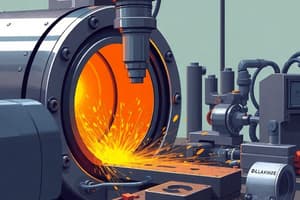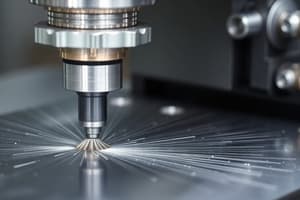Podcast
Questions and Answers
What determines the selection of the spindle rpm in a lathe operation?
What determines the selection of the spindle rpm in a lathe operation?
- The diameter of the workpiece
- The material of the workpiece
- The type of machine used
- The selected cutting speed (correct)
Which parameter does NOT directly influence the cutting speed in lathe operations?
Which parameter does NOT directly influence the cutting speed in lathe operations?
- Depth of cut (DOC)
- Revolutions per minute (rpm)
- Color of the cutting tool (correct)
- Feed rate
What is the most critical component used to machine the workpiece?
What is the most critical component used to machine the workpiece?
- The motor driving the lathe
- The cutting tool material and geometry (correct)
- The workpiece itself
- The spindle housing
What should be consulted for industrial calculations of cutting speed and feed?
What should be consulted for industrial calculations of cutting speed and feed?
What is the role of the tables of recommended values in lathe operations?
What is the role of the tables of recommended values in lathe operations?
What does V represent in the equations used for lathe operations?
What does V represent in the equations used for lathe operations?
Which of the following is NOT a factor in selecting cutting speed, feed rate, and DOC?
Which of the following is NOT a factor in selecting cutting speed, feed rate, and DOC?
What does DOC stand for in machining processes?
What does DOC stand for in machining processes?
What is the primary factor used to estimate the metal removal rate (MRR) in turning?
What is the primary factor used to estimate the metal removal rate (MRR) in turning?
Which of the following statements accurately describes turning?
Which of the following statements accurately describes turning?
In terms of power requirement during machining, which force is considered the largest?
In terms of power requirement during machining, which force is considered the largest?
When estimating the horsepower needed for a cut, which additional factor is crucial besides the metal removal rate?
When estimating the horsepower needed for a cut, which additional factor is crucial besides the metal removal rate?
How is cutting time (Tm) in turning calculated?
How is cutting time (Tm) in turning calculated?
What generally accounts for only a small percentage of the power required during cutting operations?
What generally accounts for only a small percentage of the power required during cutting operations?
What range does the metal removal rate (MRR) for turning usually fall within?
What range does the metal removal rate (MRR) for turning usually fall within?
Which category does drilling belong to in terms of tool processes?
Which category does drilling belong to in terms of tool processes?
What parameter does ϕ define in the context of machining processes?
What parameter does ϕ define in the context of machining processes?
Which term corresponds to the English term 'Turning' in German?
Which term corresponds to the English term 'Turning' in German?
Which of the following terms is NOT a machining process listed in the content?
Which of the following terms is NOT a machining process listed in the content?
What does the term 'Cutting parameters' refer to in machining?
What does the term 'Cutting parameters' refer to in machining?
In the context of the provided content, what does ψ define?
In the context of the provided content, what does ψ define?
What does the cutting speed (V) primarily relate to?
What does the cutting speed (V) primarily relate to?
How is feed (fr) measured in turning operations?
How is feed (fr) measured in turning operations?
What does the depth of cut (DOC) signify in turning?
What does the depth of cut (DOC) signify in turning?
In what units is feed typically expressed during machining?
In what units is feed typically expressed during machining?
How is the depth of cut (DOC) mathematically defined?
How is the depth of cut (DOC) mathematically defined?
What does the selection of cutting speed (V) influence in the turning process?
What does the selection of cutting speed (V) influence in the turning process?
What units are NOT typically used for measuring cutting speed?
What units are NOT typically used for measuring cutting speed?
Which factor is critical for determining the cutting speed during machining?
Which factor is critical for determining the cutting speed during machining?
What happens to the horsepower requirement when the speed is doubled?
What happens to the horsepower requirement when the speed is doubled?
Which of the following is NOT a factor that directly increases the power requirement in machining?
Which of the following is NOT a factor that directly increases the power requirement in machining?
What is the relationship between speed and cutting force, Fc, according to the findings?
What is the relationship between speed and cutting force, Fc, according to the findings?
In the context of machining, what is the purpose of the specific horsepower, HPs?
In the context of machining, what is the purpose of the specific horsepower, HPs?
What effect does increasing speed have on tool life?
What effect does increasing speed have on tool life?
What characterizes the chip formation process in machining?
What characterizes the chip formation process in machining?
Which of the following components does NOT belong to the conventional cutting force system in oblique-chip formation?
Which of the following components does NOT belong to the conventional cutting force system in oblique-chip formation?
What primarily determines the temperature increase in the chip, work, and tool during machining?
What primarily determines the temperature increase in the chip, work, and tool during machining?
Flashcards are hidden until you start studying
Study Notes
Machining Fundamentals
- Speed (V) is the primary cutting motion: it refers to the tool's velocity relative to the workpiece. Common units include surface feet per minute (sfpm), inches per minute (in./min), meters per minute (m/m), or meters per second (m/s).
- Feed (fr) is the material removed per revolution or per pass of the tool: In turning, it's measured in inches per revolution. Other units include inches per cycle, inches per minute, or inches per tooth.
- Depth of Cut (DOC) is the third dimension: In turning, it's the distance the tool is plunged into the workpiece, calculated as half the difference between the initial diameter (D1) and the final diameter (D2).
- Cutting Speed (V) & RPM (Ns): Cutting speed is directly related to the outer diameter of the workpiece and determines the RPM. The formula is: V = πDNs/12, where:
- V is the cutting speed (sfpm)
- D is the outer diameter (inches)
- Ns is the revolutions per minute (rpm)
- Cutting Tool Material & Geometry: These influence the selection of the cutting speed. For instance, the tool determines the chip formation process and plays a critical role in machining.
- Tables of Recommended Values: Metcut's Machinability Data Handbook provides tables for selecting speed and feed for turning. These tables offer conservative starting points for determining operational parameters.
- Metal Removal Rate (MRR): MRR is calculated as the volume of material removed per unit time. For turning: MRR = πDfrNs/4
- Horsepower Requirements: The power required for cutting is determined by the metal removal rate. The formula is: HP = MRR x HPs, where HPs is the unit horsepower, representing the power needed to remove a cubic inch of metal per minute.
- Chip Formation: Chip formation is a localized shear process resulting from the interaction of the tool and workpiece. The chip's shape and size depend on the tool geometry, feed, and cutting speed.
Forces and Power in Machining
- Three-Force Cutting: A majority of machining processes involve oblique cutting, generating three main forces:
- Fc (Primary Cutting Force): Acts in the direction of the cutting velocity vector. Usually, the largest and accounts for most of the power.
- Ff (Feed Force): Acts in the direction of the tool feed. Typically around 50% of Fc but contributes less to power.
- Fr (Radial or Thrust Force): Acts perpendicular to the machined surface.
- Power Requirements: Increasing speed, feed, or depth of cut increases the power needed. Doubling the speed doubles the horsepower. Doubling feed or depth of cut doubles the cutting force, Fc. Speed doesn't directly affect Fc, but it has a significant impact on tool life due to heat generation.
- Unit Horsepower (HPs): HPs is a key parameter:
- HPs = HP / MRR
- This term represents the approximate power required at the spindle to remove a cubic inch of metal per minute.
Basic Machining Processes
- Turning: Single-point tool process.
- Milling & Drilling: Multi-point tool processes.
German Terminology
- Machining Processes: Bearbeitungsprozesse
- Turning: Drehen
- Drilling: Bohren
- Milling: Fräsen
- Sawing: Sägen
- Cutting Parameters: Schneidparameter
- Speed: Geschwindigkeit
- Depth of Cut: Schnitttiefe
- Strain: Belastung
- Tensile Strength: Zugfestigkeit
Studying That Suits You
Use AI to generate personalized quizzes and flashcards to suit your learning preferences.




